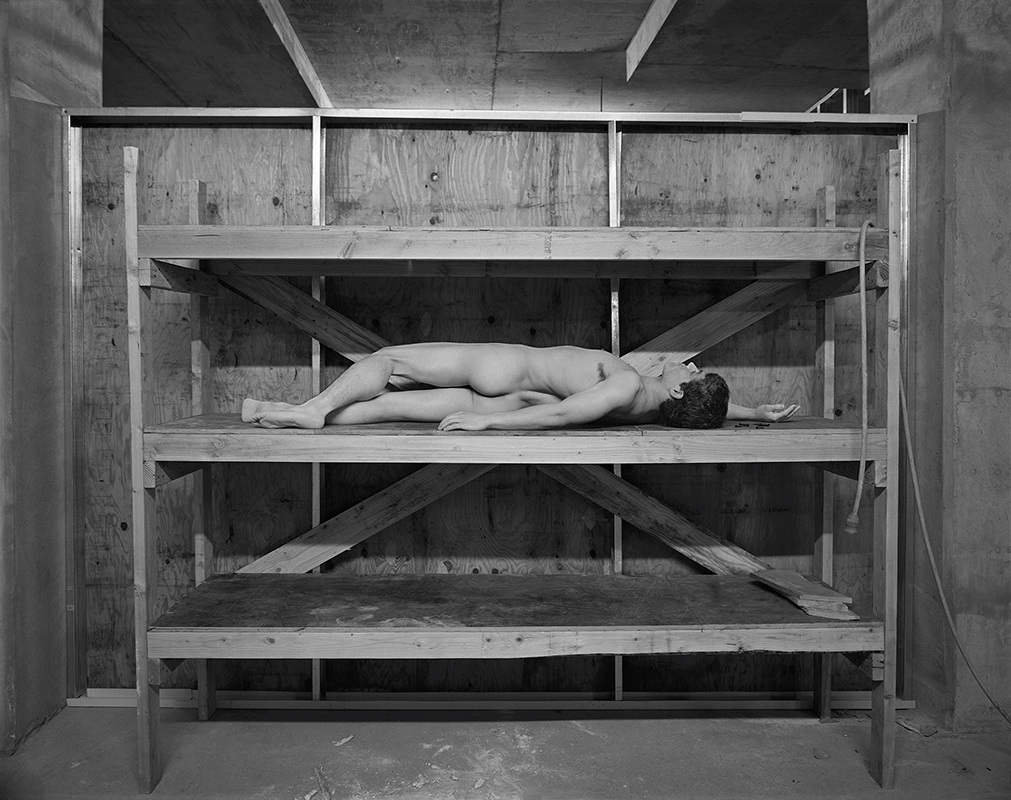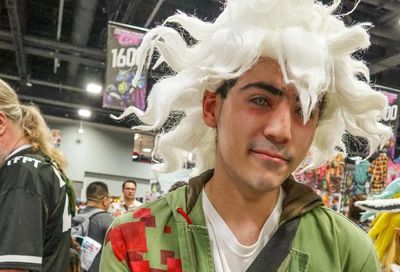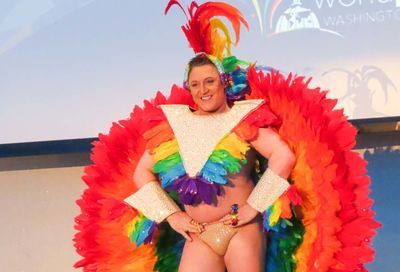Rodeo 101
A primer for the ins and outs of Atlantic Stampede
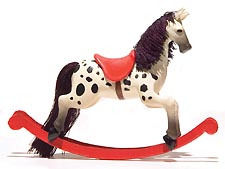 |
Think of the National Mall as the wide-open plain, Remington’s as the local honky-tonk, and summer tourists as cattle. To make the illusion complete, some 700 miles east of the Gateway to the West, the Atlantic States Gay Rodeo Association offers the rootin’est, tootin’est rodeo weekend around.
Since 1992 ASGRA’s Atlantic Stampede Rodeo has herded cowboys and cowgirls — and admirers of both — to the wilds of Maryland for gen-u-ine bronc riding, chute dogging, barrel racing, and all the rest. The added gay flair includes the ”Wild Drag Review,” the ”Wild Drag Race” and, most famously, the ”Dolly Madison Race” recreating the former first lady’s valiant efforts to save White House Americana from the torches of advancing British troops.
Atlantic Stampede is not, however, just about the dusty rodeo arena. Out at the Montgomery County Fairgrounds, there is also dancing, drinking, vendors and food. Afterward, as the sun sets each evening, happy trails lead back into town, and to spiffed-up evenings of merriment at the Hyatt Regency Washington on Capitol Hill.
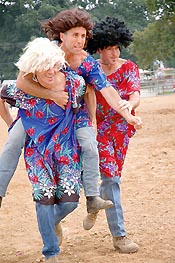 |
While the Stampede draws ever larger, devoted crowds, some people may feel a bit too intimidated to join the party. The country-western aesthetic can seem downright alien to somebody from Dupont who can lip-synch to Cher but has never heard of Kenny Chesney. Or to someone who prefers soymilk and Tegan and Sara to watching Desert Hearts. But uninitiated gay gals and fellers needn’t worry. One universal trait of the country-western set is a laid-back friendliness that lets everyone know they’re welcome. And once you’ve corralled your confidence with a few cues from the following primer, wild horses shouldn’t be able to keep you away.
Clothes Make the Cowpoke
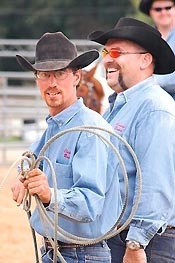 |
While rodeos don’t have dress codes, an easy way to get into the spirit of Atlantic Stampede is to dress the part. In the D.C. area, dressing country often means a trip to Carol’s Western Wear in Glen Burnie or Laurel, Md.
”We love the Stampede,” says Cindy Chance, general manager of both stores, adding that Carol’s has had a booth at every Atlantic Stampede. ”It’s the most fun event we do. It’s a great day.”
While Chance stresses the point that people should wear to the rodeo whatever makes them comfortable, she says the Carol’s booth will be fully stocked to make any on-site, head-to-toe transformations necessary. The first step, says Chance, is the hat.
”A lot of people wear something to get in the spirit, but many people come without a hat — and the hat is the essential part,” she says. ”Hats are far and away the best-seller [at the rodeo].”
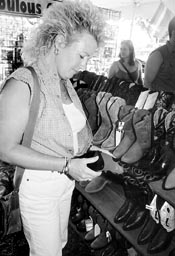 |
For the urban cowboy or cowgirl, the only real concern in choosing a hat is appearance, says Chance, insisting that if a hat doesn’t look good on a customer, she won’t mince words. ”Some hat shapes look better on some faces than others. The way you’ll tell whether it’s right for you is just how you look in the mirror. And we’ve always been pretty straightforward, because we want people to tell you you look good in it.”
Chance says ”crunchy” is the hot look for cowboy hats these days. ”Hats are really cool right now, particularly hats with ‘crunchiness.’ It’s a hat with attitude. It’s in the shape of the brim and the fact that it doesn’t look new. They’re usually straw. Toby Keith and the hats he’s wearing — that’s crunchy.”
In the cowboy-clothing hierarchy, boots are second only to hats. And by just a hair. ”A cowboy hat and loafers? I don’t think that looks good,” says Chance, granting that country-western footwear is boots, boots and more boots. One exception, she notes, may be a cowboy hat with flip-flops for a Galveston, Texas, sort of Gulf Coast Cowboy look. ”The boots have form and function. Some have a non-skid sole, which is good for riding a motorcycle or in the barn. If you’re dancing, you should have a leather sole.
”Pretty much everything in Western wear came about because of function,” she says. ”A pointy toe on a boot was to help you find the stirrup. I kind of prefer the retro, vintage pointy toe.”
A boot highlight this year, says Chance, will be the Nocona Mobile Fit Center. This rolling showroom offers samples of all the Texas-based Nocona Boot Company’s offerings in sizes AAAA to EEE.
”They’ve been around for 85 years,” Chance says. ”In the trailer they’ve got samples of every boot they make, and every size. It’s a great chance for people with hard-to-fit feet. They’re booked all through the year, and there’s only one of these trucks. They’re in Maryland once a year.”
In getting outfitted, you can relax a little once you’ve taken care of the top and bottom.
”You can’t wear the hat if you don’t have boots. What you do in the middle is an option,” says Chance, adding that she’ll be selling a range of discounted shirts, and cowboy-cut jeans not found in department stores. Then there is the final touch: ”You need the belt and buckle to get the whole effect. Buckles are hot.”
There’s no need to go whole-hog, though. Just a touch of Western might be plenty to get by.
”There won’t be many people who wear the [country-western] look from head to toe,” says Chance. ”For that, you almost need a horse. People adapt elements to go with their own style.”
One dash of style may be the hanky of infamous gay lore. This color-coded system of advertising sexual appetites runs the gamut. And county-western dress may be the only style easily accented with a bandana. For the newbie who goes that route, the basic rule of thumb is ”right equals bottom, left equals top.”
Beyond that, says Chance, you’re on your own. ”They’re something we sell in the store. There is a range of colors, but I couldn’t tell you what they mean.”
Four Legs Good
Few venues offer as much opportunity for D.C.’s city slickers to get acquainted with America’s livestock legacy as the rodeo. Patrick Hunter, who runs ASGRA’s monthly horseback trail rides, has enjoyed a lifelong love of riding and respect for the animals in the arena.
”I grew up in Massachusetts,” says Hunter, who moved to D.C. in 1997. ”That may not seem like farmland, but 30 years ago it was much more rural. There were a few horse stables where I grew up.
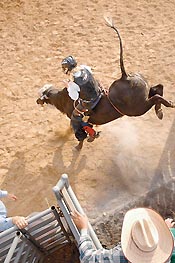 |
For those whose idea of four-legged animals comes with a bark or a purr, Hunter offers a quick rundown on the animals of the arena. Rodeo-goers will see steers, bulls, broncos, regular horses, and goats.
”Bulls are usually the big-horned animals,” Hunter explains. ”Steers are usually smaller. Steers have been castrated, bulls haven’t. Broncos are horses, but they’ve not been tamed for riding. They’re kept domestically, but not stabled. Horses are more likely to be kept in a stable, groomed, with lots of attention. They’re used to someone putting a saddle on them. Broncos aren’t used to that. If someone climbs onto their backs, they’re going to want to buck you off.”
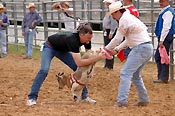 |
The goats, according to Hunter, are less high-strung. ”In the arena, ‘goat dressing’ is actually putting a pair of shorts onto a goat,” he says, referring to one of the rodeo’s campiest events. ”The goat’s really actually kind of complacent. It’s not as though you’re going to H&M and the goat goes into a dressing room. You’ve kind of got to lift the goat up.”
For those concerned about animal safety, Hunter says the cowboys and cowgirls attempting to wrestle steers and the like probably face a greater danger of injury than any of the rodeo animals. ”For any kind of rodeo, you’re going to find gobs and gobs of regulations to keep the animals safe and in good health. There’s a vet on-site to care for the animals. They’re inspected beforehand. If they’re unhealthy, they’re not in the competition. We’re required to have a special stretcher for animals in case they’re injured. They’re treated pretty well.”
Notably, unlike a farm show or a horse race, the rodeo does not offer any opportunity to view the animals outside the arena. ”It’s not a petting zoo,” says Hunter. ”At least it’s not a petting zoo with the animals. Go up into the stands and it might be a different story.”
Now You’re Talkin’
Language is often the key to getting to know any culture. While country-western culture may not pose much of a linguistic barrier for outsiders, picking up a bit of the lingo will certainly help newcomers enjoy the Atlantic Stampede.
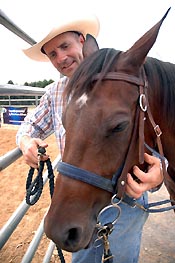 |
A fantastic source for rodeo words and phrases is ASGRA’s Web site (www.asgra.org), which offers a dictionary. Among the offerings is ”chaps,” which most people likely think they already know. According to the ASGRA site, these leggings are pronounced ”shaps.”
ASGRA president Gaither Pennington says it’s a somewhat persnickety point.
”If you pronounce it in the original Spanish, it’s ‘shaps,”’ he says. ”And ‘rodeo’ is actually pronounced ‘ro-day-o.’ Many of the terms are Spanish. Someone may correct you. It’s a gay group — we’ve got some pissy folks.”
Pissy folks aside, Pennington promises that the Atlantic Stampede weekend is a very welcoming affair for newcomers with little distinction between those in-the-know and the cowboy-compromised.
”The terms have become so generic,” says Pennington. ”There are lots of terms that are rarely ever heard. The true cowboy or cowgirl — who made a living by their wits and with a great deal of independence — have all but disappeared. There are fewer and fewer as time goes by. People like houses and heat, not necessarily living on the range.”
Even if some terms have become generic, they still carry some important meanings for a rodeo.
”Obviously, you’re going to hear ‘chute.’ That’s the stall with the gate that opens out into the arena,” Pennington offers. ”’Chute dogging’ is wrestling a steer to the ground by holding the head and horns. The ‘dogger,’ either a guy or a gal, gets into the chute…. With [rodeo] days, we call them ‘goes.’ Saturday is ‘first go,’ and Sunday is ‘second go.”’
Regardless of the linguistic nuances, Pennington says first-timers should worry about having a good time and not spare a thought to studying country-western phraseology.
”I’m the announcer for the rodeo. I always explain the events to people. We’ll explain everything to them,” he promises. ”The nice thing about the rodeo is it’s a very laid back, friendly sport. People really aren’t pompous. People are very willing to answer questions. That’s one of the things that makes it so nice. Some other [gay venues] are less user-friendly, like a stand-and-model crowd. It’s very different with a country group. It’s a warmer, kinder group of people. People in the rodeo tend to be very open, warm and accepting. Folks are just hospitable.”
Lowdown on the Hoedown (and other country dances)
Beyond the cowboy hats and broncos, most Americans think of country-western as music. And where there’s music, dancing is sure to follow. Atlantic Stampede makes the most of that fact with dance floors at both the county fairgrounds and back at the host hotel.
And though nearly anyone who has lived in the United States for a decade or more can recite at least one line from a country song (all together, now: Man, I feel like a woman), country-western dance may be the most intimidating facet of the culture. Someone who has never donned a pair of cowboy boots could fairly question where the hell everyone seems to learn these rote steps. From the outside, the ”boot scoot,” ”tush push” and all the rest are the equivalent of secret handshakes.
”The hallmark of a country bar is country music and a dance floor,” says Gaither Pennington, who along with his rodeo announcing duties, will teach dance lessons during Atlantic Stampede. ”The music and dance are integral to the country-western lifestyle.”
Pennington says he fell into country dancing almost accidentally, during his first visit to Equus, the precursor to Remington’s, in the early ’80s. ”They were doing a line-dance when I walked in,” he recalls. ”Something just clicked. I thought, ‘I’m home.’ I’d never seen anything like this. I walked right up on the stage and learned how to do the dance.”
Today, Pennington says he teaches country dancing to honor to the man began teaching him that night, Rick Coleman, who has since died. ”I learned it from somebody who enjoyed it. I like to pass on to other people something that has meant so much to me. It’s sort of like a tribute to Rick in many ways.”
Pennington puts the weekend’s dance offerings into three categories: couples dancing (which includes two-stepping), line dancing, and square dancing.
”Couples dancing requires a leader and a follower,” he says. ”This is not committee work — the leader is responsible. Waltz is an example, swing is an example. Two-step if four-four time, while a waltz is three-quarter time. The rhythm is different. But if they spirit moves me — who knows? — I just may teach a waltz. But we’re going to be doing basic two-step. You don’t need to have any experience in this it all.”
Pennington adds that if one is asked to two-step, it’s very bad form to decline, even for those with no experience whatsoever.
”If you’ve got a less experienced dancer, all you do is move to the inside track,” he says, explaining that faster dancers circulate on the outside of the dance floor, slower dancers nearer the center. ”There’s nothing to prevent someone getting on the dance floor if they’ve got an experienced partner. It’s 3 minutes and 40 seconds — anyone can last through that. And it’s a wonderful ice breaker.”
Square dancing lessons and demonstrations will be offered, thanks to the DC Lambda Squares and Howard Richman, though hoedowns (square dances) have not proven quite as popular as two-stepping and line dancing. Pennington figures it’s a matter of logistics, in that square dancing requires a caller and eight people to get started.
Line-dancing, in contrast, requires not much at all. ”A line dance is a dance performed by a single person,” says Pennington. ”There is no partner. And it’s called a ‘line dance’ because it’s in a line. Everyone is supposed to stay in place, like in the military when you fall into formation. Every dancer is in the matrix and is supposed to maintain that position. Everyone does exactly the same step, which can be fairly simple or fairly complex.
”One other thing about etiquette,” he continues. ”The first couple on the dance floor determines the dance. If they start a line dance, everybody else joins in.”
With seven dance lessons planned for the course of the weekend, anyone should be able to gain the confidence to take a twirl. ”We have a fairly brief period to teach, so we’re going to pick something pretty straight forward,” promises Pennington. ”[Dancing] is part of the experience, it’s part of the fun, and it’s wonderful exercise. And there’s nothing better than holding someone or being held.”
Stampede Dos and Don’ts
Every social situation is a potential minefield of faux-pas. As friendly and relaxed as it may be, Atlantic Stampede is no different. Considering all the livestock at the rodeo, attendees literally have to beware putting a foot in it, so to speak.
”You wipe it off and keep right on going. And it does happen,” warns Jymmye Jaymes, the current Miss ASGRA, doyen of rodeo etiquette. ”If I’m going to be anywhere near the rodeo, I’ll wear an old pair of boots.”
If the rodeo can get Jymmye Jaymes out of her heels, a good rule of thumb is no heels for anyone. ”It’s the fairgrounds. It’s all dirt. If I’m not going to be in the arena, I just wear a nice pair of cowboy boots, but they’re still going to get dirty. I wouldn’t recommend flip-flops.”
For those who’ve never felt the inside of a pump, Jaymes has words of advice for the shit-kickin’ crowd as well: ”The beer trucks are there. There is a bar set up. But if you’re going to be up in the bleachers and it’s a hot, sunny day, you don’t want to drink. You get people who will drink and party, but they won’t be in the stands. Just follow common sense — and have a designated driver.”
As for the different venues, Jaymes says it’s a question of corrals and kids, versus adults and eveningwear.
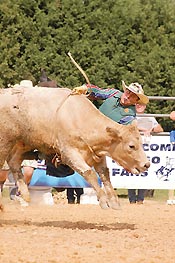 |
”At the rodeo, we’re there to watch the rodeo. A lot of people are there to watch. It’s as if you were going to a fair, because we do draw families. We have a lot of straight supporters. We’ve got kids around, so you want to be careful,” Jaymes cautions. ”At the hotel, it’s a party and everyone dresses in their finest. You don’t want to show up at the hotel in the same dusty clothes you were wearing to the rodeo.”
Jaymes echoes Pennington’s warning that to decline an invitation to dance is one of the worst possible breaches of etiquette one could commit during Atlantic Stampede. ”The proper form, if you’re new, is to say you’re new and ask your partner to lead,” instructs Jaymes. ”If it were me, I would say, ‘Would you like to dance? I’m a follower, I hope you’ll lead.’ Or, ‘I’m a leader, but I can follow if I have to.”’
With the sense of diplomacy demanded of title holders, Jaymes has a special note for locals to be on their best behavior, in that each is a representative of the area for out-of-town guests. ”Don’t act like an ass,” says Jaymes. ”We get a lot of people from across the country at Atlantic Stampede. Say, ‘Hi, welcome to the nation’s capital.”’
And for newcomers: ”If you have a question about something, ask somebody. And have a good time. That’s what you’re there for.”
The Cowboy/Cowgirl State of Mind
The best way to get in the spirit of the Atlantic Stampede may have far less to do with learning a line dance, slipping into cowboy boots or watching a cowgirl wrestle a steer. It may be as simple as a state of mind. Rudy Benavides and Busty Bottoms, Mr. and Ms. ASGRA 2005, respectively, have their ideas about what it means to be a cowboy or cowgirl.
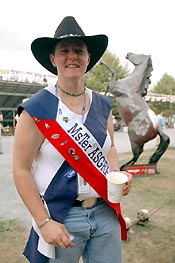 |
”To me, personally, being a cowboy is definitely a state of mind,” says Benavides. ”I’m originally from Texas. I grew up around horses and cattle, but I still think being a cowboy is a state of mind…. It’s kind of hard to explain. To me, a cowboy is someone who’s been on the range. He’s usually by himself, working on the plains. I pretty much take care of myself, do it on my own. I don’t like anyone to help me. It’s self-sufficiency.”
Bottoms, on the other hand, wasn’t born into a cowgirl way of life. Not even close.
”It started about a year ago,” says the D.C.-area native. ”I knew some people who were part of ASGRA. They talked me into running for the title. I thought, ‘What the heck.’ [Before ASGRA] I was very eclectic. At times I was a ‘goth chick,’ at times a ‘club girl.’ I just kind of combined them all into one. I’ve recruited country-western into what I am as a person. I still have my clubby moments, my goth moments.”
Using Benavides and Bottoms as examples of what it means to be country-western and gay in the D.C. metro area, it seems there is quite a range. Benavides seems to have a love for the rodeo arena, while ASGRA brought out the performer in Bottoms.
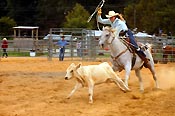 |
”I started performing through being part of ASGRA,” Bottoms says, explaining that ASGRA’s relaxed atmosphere allowed her to grow. ”I’m a ‘bio-queen.’ In basic terms, I’m a real girl who performs like a drag queen. I’m known for doing Gretchen Wilson’s ‘Here for the Party.’ That was the song I used to compete with. I knocked down a lot of walls to do that. It’s not just ASGRA, but the whole country-western lifestyle. It’s very laid back. I can wear a pair of jeans and no makeup and feel fine.”
Despite their differences, the laid-back jeans lifestyle is a plus for Benavides as well.
”[To be a cowboy] you have to be around the country-western lifestyle, the rodeo lifestyle, and be around people who’ve adopted that as a way of life,” he says. ”Working on Capitol Hill myself, I’m still around people who’ve adopted that lifestyle. Even though I live in the city, I still wear my Wranglers and cowboy boots. I get a lot of looks.”
Bottoms and Benavides both point to a certain romanticism that draws them to the cowgirl/cowboy life. For Bottoms, she says there is the fantasy of a being carried away by a sexy woman on horseback. ”Luckily, I have a partner right now,” she says. ”She lives in South Carolina, so she has the natural essence of being Southern.”
For Benavides, he is living the fantasy, in a sense, competing in the arena as a cowboy couple. ”We just started partnering up [in the arena] together earlier this year,” says Benavides, referring to his partner of five years. ”We partnered for the wild drag race and won a buckle. After that, we decided not to break up the team. We get dirty and tossed around together.”
From his Texas-ranch roots to his steer-riding present, Benavides is about as cowboy as cowboy can be. From goth chick to pigskin boots, Bottoms says she is still developing her cowgirl identity. She has, however, found a phrase in country-western culture that she says sums up this newer part of her persona: ”cowgirl up.”
The phrase, common on the rodeo circuit is particularly important to Bottoms, who would like to compete in the arena once she recovers from complications related to a broken ankle.
”’Cowgirl up’ means you might’ve fallen, but you get back up again,” says Bottoms. ”My dream is to compete in horseracing in the arena — barrel racing or pole racing. Whether riding rough stock, or steer wrestling, the women are just as involved as the men are. That’s what’s nice. Women do get respect in this community.”
Looking at the same ASGRA sensibilities, Benavides adds: ”The rodeo association, it’s a huge family. It’s a sense of belonging. There’s dancing, there’s the rodeo. It’s a lot of fun. If people don’t like the rodeo itself, they can grab a cocktail and go dance. You’ve got shirtless cowboys walking around, which is nice. And everyone is so friendly.”
ASGRA’s 2005 Atlantic Stampede will be held Saturday, Sept. 10 and Sunday, Sept. 11., at the Montgomery County Agricultural Fairgrounds in Gaithersburg, Md. Tickets are $15 for each day. Evening dances will be held at the Hyatt Regency on Capitol Hill, 400 New Jersey Avenue NW, on Friday, Sept. 9 and Saturday, Sept. 10. Tickets to the dances are $15 each evening. A weekend pass, including both dances and both days of rodeo costs $55. For more information and a full schedule of events, visit www.asgra.org.
Support Metro Weekly’s Journalism
These are challenging times for news organizations. And yet it’s crucial we stay active and provide vital resources and information to both our local readers and the world. So won’t you please take a moment and consider supporting Metro Weekly with a membership? For as little as $5 a month, you can help ensure Metro Weekly magazine and MetroWeekly.com remain free, viable resources as we provide the best, most diverse, culturally-resonant LGBTQ coverage in both the D.C. region and around the world. Memberships come with exclusive perks and discounts, your own personal digital delivery of each week’s magazine (and an archive), access to our Member's Lounge when it launches this fall, and exclusive members-only items like Metro Weekly Membership Mugs and Tote Bags! Check out all our membership levels here and please join us today!





